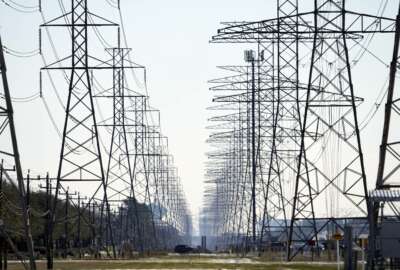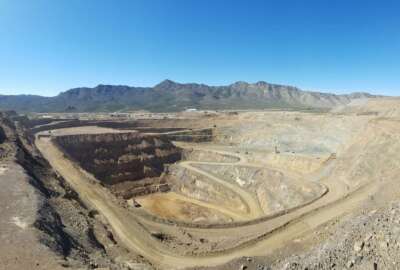

Hubbard Radio Washington DC, LLC. All rights reserved. This website is not intended for users located within the European Economic Area.
As the National Park Service enters its second spring since the pandemic, growing numbers of Americans are vaccinated and looking forward to a little normalcy o...
Best listening experience is on Chrome, Firefox or Safari. Subscribe to Federal Drive’s daily audio interviews on Apple Podcasts or PodcastOne.
As the National Park Service enters its second spring since the pandemic, growing numbers of Americans are vaccinated and looking forward to a little normalcy outdoors. So there’s special meaning in this year’s annual National Parks Week. Spokeswoman Kathy Kupper gave a few of the highlights to Federal Drive with Tom Temin.
Interview transcript:
Tom Temin: Ms. Kupper, good to have you on.
Kathy Kupper: Hi, Tom. Thanks for having me on to talk about National Parks.
Tom Temin: And let’s talk about the visitors to National Parks because it was really a strange year last spring and summer as we know. What does the numbers show with respect to say the prior year? And what are you expecting for visitor levels in general? We don’t need it down to the individual footfall., but what are the trends coming out of last year and how were the numbers affected from the year before?
Kathy Kupper: Sure. Last year, overall, throughout the country, there were 237 million visitors to National Parks. So that’s still quite a few people during the pandemic. The year before there were about 328 million. So there was a drop, but there were temporary closures. And also there are historic homes and some structures like that where visitors are still not able to enter. Also in perspective, many parks once they began to reopen, and most natural areas, outdoor areas did remain open as much as possible throughout the year. So we saw many parks set records in visitation throughout the year, and that’s continuing, that trend is going on this year as well. So from local parks like Fort Washington, and Manassas, and C&O Canal, we see the numbers still continuing to rise as people really get outside to be able to recreate responsibly be around other people safely at a distance, and get out and enjoy the fresh air and get the physical and psychological benefits that come from spending time in nature.
Tom Temin: And so you’re expecting those numbers to keep rising and might hit similar numbers that you had … [dog barking] …. He wants to get outside too. Your hitting numbers probably matching the year before 2019 perhaps this year.
Kathy Kupper: Last year shows us we can never speculate on what visitation numbers will be because you never know what will happen. But certainly the trend is continuing with the first few months of this year parks again setting records and visitation and seeing not just repeat visitors, but also many people who discovered parks, people that maybe did other vacation opportunities or didn’t know about just the vast number of parks throughout the country. Most people think of a trip to a National Park is that big destination vacation. But there are national parks in every single state and usually closer than people imagine. So they’re quick day trips as well or weekend trips. And especially as people look for these close to home opportunities to do things without being able to travel, many discovered parks perhaps close to their backyards that they never knew about. And we see them continuing to go back and use those parks.
Tom Temin: And one of the trends been for the virtual visits? I know NPS offered tours that you can take online, and that’s part of the mix of this year’s National Parks Week. How many people do this and what are the most popular online destinations so to speak?
Kathy Kupper: Well, last year the National Park Service website had a half a billion page views, so a lot of visitors virtually as well. The most visited sites tend to be the webcams, we have the webcam up at Denal that shows the puppies that pull the sleds, we have the tap my bears where they feed up getting ready for the winter. Old Faithful is a popular webcam Channel Islands, Great Smoky. So a lot of people visiting parks through webcams. There’s a lot of online activities with Rangers doing educational programs, and also general programs. So visitors can still get that experience through these virtual tours, scavenger hunts kids activities. And also we have a virtual passport stamp program. A lot of visitors to parks know that you can go and get your stamp when you visit a park. And so there’s an opportunity even when you visit a park online to get a virtual passport stamp to show that you completed activities. Another fun thing people have been taking advantage of the Junior Ranger program is very popular and kids in parks get a booklet and they do parks specific activities and then get a badge and get sworn in as Junior Rangers at the end of that program. You can download a book and do them online. And in fact this Saturday night we’re going to do a big virtual swearing in ceremony on National Junior Ranger day at 7pm on the NPS Facebook page and the Secretary of the Interior will be swearing in children who have completed their Junior Ranger program this week.
Tom Temin: Sounds like fun. And with the upcoming season and anticipated more people in person, what are the protocols that NPS has put in place and do you vary them depending on how bad that particular state might be in general on the infection rates?
Kathy Kupper: Well, every trip to a National Park should start at home by visiting the website or also we’ve recently unveiled a new app. So it’s one stop shopping off 423 national parks are in one app, that’s been popular with about a quarter million downloads since it was unveiled recently, so it’s best to go there and get the updates as to hours and what’s available. And for protocols, all federal recreation lands, there’s a mask mandate for all buildings, and also outside where you cannot be physically distanced from other people. So even on trails that are crowded, and so forth to wear the mask, and we asked everybody to recreate responsibly. As we’ve talked about our public lands, we are so happy to see people out and using them. But we ask also that everybody do their part to help preserve these lands. They’re here for us to enjoy and for future generations. So please follow regulations, stay on trails, watch yourself around water, all the basic safety things as more and more people discover and use these places just to be respectful of the areas so that it can stay around and not just other visitors today, but into the future so they can also enjoy these beautiful magnificent places.,
Tom Temin: Yeah leave the flowers un-plucked as you walk by the pathway there. And of course, there’s well known that the NPS has a multi billion dollar maintenance backlog, were you able to catch up on any of that because of the lower visitor levels in the past year?
Kathy Kupper: Yes and no, because of course, many projects who were also stopped due to COVID regulations, there were projects here in the DC area of people who were happy to see the completion of the Memorial Bridge project. The other thing that’s very exciting that happened over the last year is last August, the great American Outdoors Act was passed. And so that will provide about up to $6 billion a year to National Parks to help with the maintenance backlog. And so a lot of the pre planning was done so that we can begin construction, getting them shovel ready, one of the exciting projects coming up will be rehabilitation of a very popular part of the GW Parkway. So a lot of parks are able to lay the groundwork to get ready for projects that will be funded by that legislation.
Tom Temin: So that will literally be hell on wheels until it’s fixed. Then it’s gonna be heaven.
Kathy Kupper: Yeah, it’ll be a very popular stretch from that’ll run out to 495. And you know, it’ll repair the road, but also people sometimes don’t think about everything that goes into the drainage systems and the structure and the bridges and the supports and the safety measures. There’s a lot more than meets the eye. And it’s the same when you go to a park. And always the idea about are the bathrooms clean, when you think beyond the bathroom, just the water to get it into the bathrooms are the superstructure, especially behind remote parks out in the wilderness. When you hit that restroom, there’s been a lot of superstructure underneath to get that to where it is, a lot of the repairs are that idea kind of that deferred maintenance that you might not see, but actually supports enhance visitor opportunities and recreation.
Tom Temin: That’s right, got to keep those groovers clean. And finally, what about the volunteers this spring? Are they allowed to come back and we reintroduce volunteers?
Kathy Kupper: Yeah. And in fact, that’s another thing that went virtual. Some parks have adapted, and they have virtual volunteers working on websites and collections and things of that nature. We’ve also continued what you might see as some of the traditional volunteer opportunities. So there are still trail construction and rehab and pulling of exotic species. But they’ve been done with protocols in place where people don’t work as closely as they maybe did before. And we have a very nice one coming up this week with Park Week at flight 93, where they’ve been planting tree saplings to restore the landscape there. And so we’re going to have about 200 volunteers spaced out planting hundreds of tree saplings so those opportunities exist still. And then also it’s best to check with your local park where you might want to volunteer to see what opportunities they have virtually and also as they begin to bring volunteers back in who are dealing face to face with the public.
Tom Temin: Alright, I recommend going out to see the Flight 93 place, it’s one of the stunning zones operated by the National Park Service. I can vouch for that personally. Kathy Kupper is a Public Affairs Specialist with the National Park Service. Thanks so much for joining me.
Kathy Kupper: Sure. Thank you. Happy National Parks Week.
Copyright © 2024 Federal News Network. All rights reserved. This website is not intended for users located within the European Economic Area.
Tom Temin is host of the Federal Drive and has been providing insight on federal technology and management issues for more than 30 years.
Follow @tteminWFED


